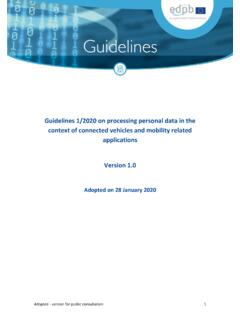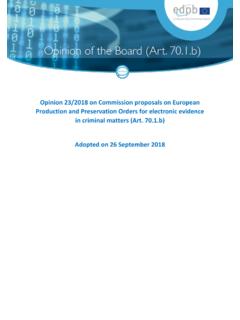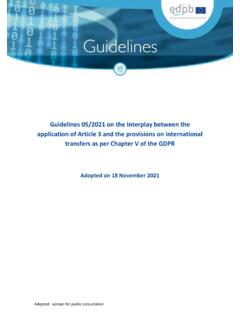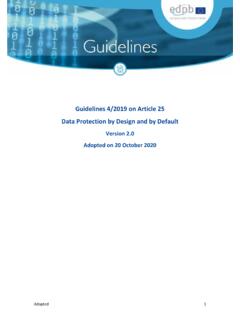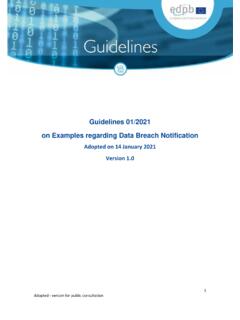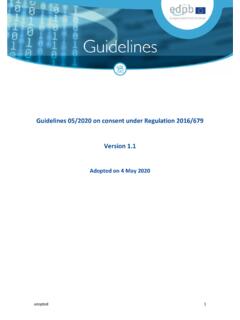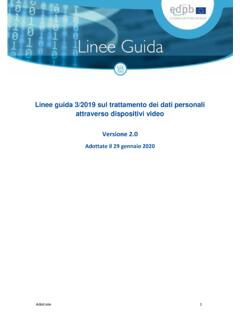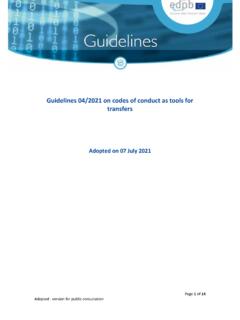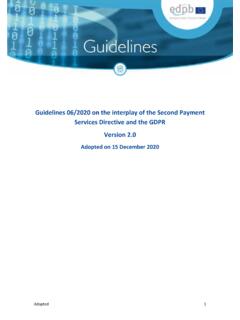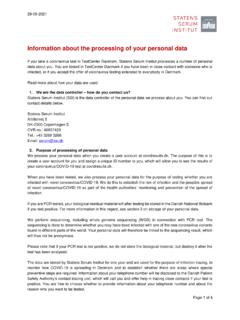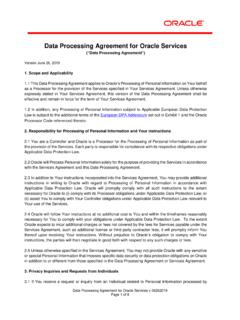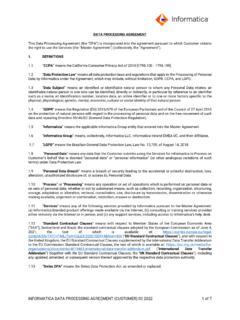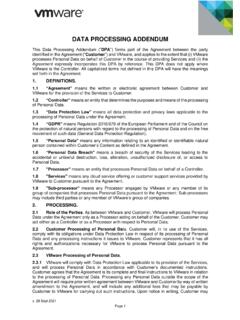Transcription of Guidelines 3/2019 on processing of personal data through ...
1 EDPB Plenary meeting, 09-10 July 2019. Guidelines 3/2019 on processing of personal data through video devices Version for public consultation Adopted on 10 July 2019. adopted 1. Table of contents 1 4. 2 Scope of application .. 5. personal data .. 5. Application of the Law Enforcement Directive, LED (EU2016/680) .. 5. Household exemption .. 6. 3 Lawfulness of 7. Legitimate interest, Article 6 (1) (f) .. 7. Existence of legitimate interests .. 8. Necessity of processing .. 8. Balancing of interests .. 9. Necessity to perform a task carried out in the public interest or in the exercise of official authority vested in the controller, Article 6 (1) (e).
2 11. Consent, Article 6 (1) (a).. 12. 4 Disclosure of video footage to third 12. Disclosure of video footage to third parties in 12. Disclosure of video footage to law enforcement agencies .. 13. 5 processing of special categories of data .. 14. General considerations when processing biometric 15. Suggested measures to minimize the risks when processing biometric data .. 18. 6 Rights of the data 18. Right to 18. Right to erasure and right to object .. 20. Right to erasure (Right to be forgotten).. 20. Right to object .. 20. 7 Transparency and information obligations .. 21. First layer information (warning sign).
3 22. Positioning of the warning sign .. 22. Content of the first layer .. 22. Second layer information .. 23. 8 Storage periods and obligation to 24. 9 Technical and organisational measures .. 24. Overview of video surveillance system .. 25. data protection by design and by 26. Concrete examples of relevant 26. adopted 2. Organisational 27. Technical measures .. 28. 10 data protection impact 28. adopted 3. The European data Protection Board Having regard to Article 70 (1e) of the Regulation 2016/679/EU of the European Parliament and of the Council of 27 April 2016 on the protection of natural persons with regard to the processing of personal data and on the free movement of such data , and repealing Directive 95/46/EC, (hereinafter GDPR ), Having regard to the EEA Agreement and in particular to Annex XI and Protocol 37 thereof, as amended by the Decision of the EEA joint Committee No 154/2018 of 6 July 2018, Having regard to Article 12 and Article 22 of its Rules of Procedure of 25 May 2018, revised on 23.
4 November 2018, HAS ADOPTED THE FOLLOWING Guidelines . 1 INTRODUCTION. 1. The intensive use of video devices has an impact on citizen's behaviour. Significant implementation of such tools in many spheres of the individuals' life will put an additional pressure on the individual to prevent the detection of what might be perceived as anomalies. De facto, these technologies may limit the possibilities of anonymous movement and anonymous use of services and generally limit the possibility of remaining unnoticed. data protection implications are massive. 2. While individuals might be comfortable with video surveillance set up for a certain security purpose for example, guarantees must be taken to avoid any misuse for totally different and to the data subject unexpected purposes ( marketing purpose, employee performance monitoring etc.)
5 In addition, many tools are now implemented to exploit the images captured and turn traditional cameras into smart cameras. The amount of data generated by the video, combined with these tools and techniques increase the risks of secondary use (whether related or not to the purpose originally assigned to the system) or even the risks of misuse. The general principles in GDPR (Article 5), should always be carefully considered when dealing with video surveillance. 3. Video surveillance systems in many ways change the way professionals from the private and public sector interact in private or public places for the purpose of enhancing security, obtaining audience analysis, delivering personalized advertising, etc.
6 Video surveillance has become high performing through the growing implementation of intelligent video analysis. These techniques can be more intrusive ( complex biometric technologies) or less intrusive ( simple counting algorithms). Remaining anonymous and preserving one's privacy is in general increasingly difficult. The data protection issues raised in each situation may differ, so will the legal analysis when using one or the other of these technologies. 4. In addition to privacy issues, there are also risks related to possible malfunctions of these devices and the biases they may induce. Researchers report that software used for facial identification, recognition, or analysis performs differently based on the age, gender, and ethnicity of the person it's identifying.
7 Algorithms would perform based on different demographics, thus, bias in facial recognition threatens to reinforce the prejudices of society. That is why, data controllers must also ensure that biometric adopted 4. data processing deriving from video surveillance be subject to regular assessment of its relevance and sufficiency of guarantees provided. 5. Video surveillance is not by default a necessity when there are other means to achieve the underlying purpose. Otherwise we risk a change in cultural norms leading to the acceptance of lack of privacy as the general outset. 6. These Guidelines aim at giving guidance on how to apply the GDPR in relation to processing personal data through video devices.
8 The examples are not exhaustive, the general reasoning can be applied to all potential areas of use. 2 SCOPE OF APPLICATION1. personal data 7. Systematic automated monitoring of a specific space by optical or audio-visual means, mostly for property protection purposes, or to protect individual s life and health, has become a significant phenomenon of our days. This activity brings about collection and retention of pictorial or audio-visual information on all persons entering the monitored space that are identifiable on basis of their looks or other specific elements. Identity of these persons may be established on grounds of these details.
9 It also enables further processing of personal data as to the persons presence and behaviour in the given space. The potential risk of misuse of these data grows in relation to the dimension of the monitored space as well as to the number of persons frequenting the space. This fact is reflected by the General data Protection Regulation in the Article 35 (3) (c) which requires the carrying out of a data protection impact assessment in case of a systematic monitoring of a publicly accessible area on a large scale, as well as in Article 37 (1) (b) which requires processors to designate a data protection officer, if the processing operation by its nature entails regular and systematic monitoring of data subjects.
10 8. However, the Regulation does not apply to processing of data that has no reference to a person, if an individual cannot be identified, directly or indirectly. Example: The GDPR is not applicable for fake cameras ( any camera that is not functioning as a camera and thereby is not processing any personal data ). However, in some Member States it might be subject to other legislation. Example: Recordings from a high altitude only fall under the scope of the GDPR if under the circumstances the data processed can be related to a specific person. Example: A video camera is integrated in a car for providing parking assistance.
